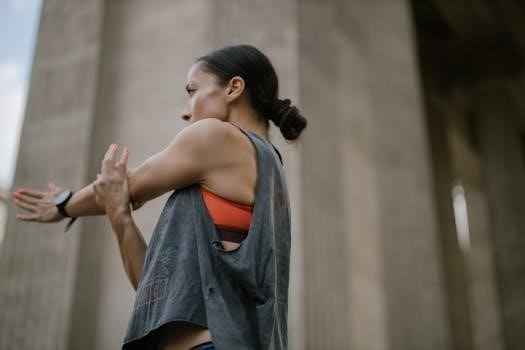Psoas Muscle Stretches⁚ A Comprehensive Guide
This guide provides comprehensive insights into psoas stretches, focusing on lengthening and strengthening this vital muscle group. Learn proper techniques, breathing exercises, and precautions to avoid overstretching. Explore various stretches and exercises for optimal psoas health.
Understanding the Psoas Muscle Group
The psoas muscle group, consisting of the psoas major, psoas minor, and iliacus, plays a crucial role in hip flexion and spinal stabilization. Often referred to as the “hip flexors,” these muscles connect the lumbar spine to the femur, impacting posture, balance, and movement. The iliopsoas, a combination of the iliacus and psoas major, is a powerful hip flexor.
Understanding the anatomy and function of the psoas is essential for effective stretching and exercise. A tight or weak psoas can contribute to lower back pain, hip discomfort, and postural imbalances. Recognizing the influence of the psoas on overall body mechanics allows for targeted interventions to improve flexibility, strength, and stability.
Proper breathing techniques are vital when working with the psoas, as the muscle’s proximity to the diaphragm affects respiration. Engaging in regular psoas stretches can alleviate tension, enhance mobility, and promote a healthier, more balanced physique. Prioritizing psoas health contributes to overall well-being and optimal physical performance.
Importance of Psoas Stretches
Psoas stretches are vital for maintaining flexibility and function in the hip flexors, directly impacting posture and movement. A tight psoas muscle can lead to lower back pain, limited hip mobility, and postural imbalances. Regular stretching helps release tension, improve range of motion, and alleviate discomfort.
Incorporating psoas stretches into a routine can enhance athletic performance by promoting efficient movement patterns and reducing the risk of injury. Stretching the psoas can improve stability, balance, and core strength, essential for various physical activities.
Furthermore, psoas stretches promote relaxation and reduce stress by releasing tension in the core and hip region. This can positively affect overall well-being and contribute to a more balanced, pain-free lifestyle. Addressing psoas tightness through targeted stretches can improve posture, reduce lower back strain, and enhance daily function. Integrating psoas stretches into a wellness regimen is crucial for maintaining optimal physical health.

Types of Psoas Stretches
Discover diverse psoas stretches like kneeling hip flexor, wall psoas, and table iliopsoas stretches. Each targets the psoas muscle differently, promoting flexibility and relieving tension. Regular practice enhances hip mobility and reduces lower back discomfort.
Kneeling Hip Flexor Stretch
The kneeling hip flexor stretch is effective for targeting the psoas muscle. Begin by kneeling on one knee, ensuring the other leg is forward, bent at a 90-degree angle. Gently push your hips forward, feeling the stretch along the front of the kneeling side’s hip. If kneeling is uncomfortable, use a bed or table to rest the back leg.
Maintain proper posture and engage your core to avoid overextending your lower back. Breathe deeply throughout the stretch, holding the position for 30 seconds, repeating several times. This helps to release tension and improve hip flexibility. For an alternative, take a long step forward with the non-stretching leg, moving the hips forward. This variation can deepen the stretch and target different areas of the psoas muscle.
Remember to perform the stretch slowly, maintaining normal respiration. If you feel any pain, stop immediately and consult a qualified instructor. Regular practice will help improve your psoas muscle health.
Wall Psoas Stretch
The wall psoas stretch is an effective, yet intense, method for releasing tension in the psoas muscle. Proceed cautiously, gradually increasing the stretch’s intensity. Begin by lunging down in front of a wall. Rest one foot against the wall, ensuring it’s secure. Slowly bring your knee closer to the wall, intensifying the stretch.
Focus on rotating your hips backward to further engage the psoas. This rotation is key to maximizing the stretch’s benefits. Remember to breathe deeply throughout the exercise, allowing your body to relax and release tension. Hold the stretch for 30 seconds, then repeat on the opposite side.
Be mindful of your body’s signals during this stretch. If you experience any sharp pain, immediately stop and adjust your position. The wall psoas stretch can be a powerful tool for improving flexibility and relieving lower back pain, but it’s essential to approach it with caution and awareness. Regular practice will help.
Table Iliopsoas Stretch
The Table Iliopsoas Stretch is a variation that allows for a deeper stretch. Begin by lying on your back near the edge of a table or bed. Position yourself so that the leg you intend to stretch is near the edge, allowing it to hang freely. Bend your opposite hip and knee towards your chest, holding it in place.
This action helps stabilize your pelvis and isolate the stretch to the iliopsoas muscle. Allow the leg hanging off the table to relax completely. You should feel a stretch in the front of your hip and upper thigh. If you don’t feel a stretch, gently pull the bent knee closer to your chest.
Hold this position for 30 seconds, breathing deeply and evenly. Remember to maintain a relaxed posture throughout the stretch. Avoid arching your back excessively. Repeat the stretch on the other side. This stretch is particularly beneficial for those who spend long periods sitting. Consistent practice can improve hip flexibility and alleviate lower back discomfort.

Psoas Stretches with Props
Utilizing props such as straps and towels can enhance psoas stretches, deepening the muscle engagement and improving flexibility. These tools aid in achieving proper alignment and supporting the stretch.
Using a Strap or Towel
Incorporating a strap or towel into your psoas stretches can significantly enhance their effectiveness. These props allow for a deeper stretch and improved control, especially when reaching for the foot in stretches like the kneeling hip flexor stretch. Wrap the strap around your foot, holding the ends with your hands, and gently pull to deepen the stretch.
This technique is particularly useful if you have limited flexibility or are just beginning to explore psoas stretches. A towel can provide a similar assist, offering a gentler approach for those with sensitive joints or muscles. By using a strap or towel, you can modify the stretch to suit your individual needs and gradually increase the intensity as your flexibility improves.
Remember to maintain proper form and avoid overstretching. The goal is to feel a gentle pull, not sharp pain. Breathe deeply throughout the stretch to further relax the psoas muscle and promote optimal results. These props are versatile tools for a safe and effective psoas stretching routine.

Psoas Exercises Beyond Stretching
Beyond static stretches, certain exercises actively engage the psoas, promoting strength and stability. These exercises complement stretching, enhancing overall hip flexor function and core stability. Proper form and gradual progression are key.
Psoas Lift Exercise
The Psoas Lift is a targeted exercise designed to strengthen the psoas muscle directly. To perform this exercise, begin by lying on your back with your knees bent and your feet flat on the floor. Allow one leg to gently fall out to the side, focusing on controlled movement. Simultaneously, engage your core and press the opposite hip slightly off the floor, holding this position for approximately ten counts.
This deliberate action isolates the psoas muscle, promoting its activation and strengthening. Ensure you maintain proper form throughout the exercise to prevent any strain or injury. Repeat this sequence on the opposite side, alternating legs for a balanced workout. For an added challenge, consider incorporating a Kegel exercise at the end of each repetition to further engage the core and pelvic floor muscles.
Remember to breathe deeply and evenly throughout the exercise, maintaining a steady rhythm. This helps to oxygenate the muscles and improve overall performance. Consistent practice of the Psoas Lift can contribute to enhanced hip flexor strength and stability, supporting better posture and movement patterns.
Toning Exercises for the Psoas
Toning the psoas muscle requires specific exercises that engage it directly. Begin in a constructive rest position, lying on your back with your knees bent and feet flat on the floor, ensuring your lower back maintains a natural curve. Gently extend one leg straight out, keeping it slightly elevated off the floor. Simultaneously, press the opposite foot firmly into the floor to assist in lifting the extended leg approximately two inches.
This action focuses on engaging the psoas muscle to lift and stabilize the leg. Proceed slowly and avoid overexertion, particularly when starting this exercise. Maintain a controlled and deliberate movement, focusing on feeling the psoas muscle activate. Repeat this exercise several times, alternating between legs to ensure balanced muscle development.
Remember to breathe deeply throughout the exercise, using each exhale to further engage the core and stabilize the spine. Consistency is key to effectively toning the psoas, so incorporate this exercise regularly into your routine. As you progress, you can gradually increase the duration and intensity of the exercise to further challenge the muscle and enhance its strength.

Considerations and Precautions
When performing psoas stretches, prioritize safety. Proper breathing and avoiding overstretching are crucial. Consult a qualified instructor if needed. Progress slowly, respecting your body’s limits to prevent injury.
Proper Breathing Techniques
Effective breathing is paramount during psoas stretches, aiding muscle relaxation and enhancing stretch effectiveness. Focus on deep, diaphragmatic breaths, inhaling slowly through the nose and exhaling fully through the mouth. Coordinate your breath with the stretch, inhaling as you prepare and exhaling as you deepen the position.
Avoid holding your breath, as this creates tension and restricts blood flow. Instead, maintain a steady, rhythmic breathing pattern throughout the stretch. As you exhale, consciously release any tension in your psoas and surrounding muscles. This allows for a greater range of motion and reduces the risk of injury.
Proper breathing also supports core stability and promotes a sense of calm, essential for optimal stretching. Visualize the breath moving into the psoas area, nourishing and releasing tightness. Consistent practice of these breathing techniques will significantly improve the benefits of your psoas stretches, leading to greater flexibility, reduced pain, and improved overall well-being. Remember to listen to your body and adjust your breathing as needed to maintain comfort and control.
Avoiding Overstretching
Overstretching the psoas muscle can lead to injury and discomfort, hindering progress. It is crucial to listen to your body and respect its limits during psoas stretches. Avoid pushing yourself beyond a comfortable range of motion; the stretch should feel gentle, not painful.
Progress gradually, increasing the intensity of the stretch over time as your flexibility improves. If you experience sharp pain, stop immediately and adjust your position. It’s better to err on the side of caution and perform a less intense stretch correctly than to force a deeper stretch and risk injury.
Remember that everyone’s body is different, and flexibility varies. Comparing yourself to others can lead to overstretching. Focus on your own individual progress and listen to your body’s signals. Warm up your muscles before stretching to improve elasticity and reduce the risk of injury.
If you have any pre-existing conditions, consult a healthcare professional before starting psoas stretches. They can provide personalized guidance and modifications to ensure your safety. Prioritize proper form over depth, and always breathe deeply to promote relaxation and avoid tension.
Integrating Psoas Stretches into a Routine
Incorporating psoas stretches into your daily or weekly routine can significantly improve flexibility, posture, and overall well-being. Consistency is key to achieving lasting results. Start by identifying a convenient time and place for your stretches, such as morning, evening, or after a workout.
Begin with a few basic psoas stretches and gradually increase the variety and intensity as you become more comfortable. Aim for at least 2-3 sessions per week, allowing for rest days in between. Listen to your body and adjust the frequency and duration of stretches based on your individual needs and limitations.
Combine psoas stretches with other forms of exercise, such as yoga, Pilates, or general strength training, to create a well-rounded fitness program. Consider incorporating psoas stretches into your warm-up or cool-down routine to prepare your muscles for activity or promote recovery.
Be mindful of your posture throughout the day, and take breaks to stretch your psoas if you spend long periods sitting or standing. Remember to breathe deeply and focus on relaxing your muscles during each stretch. Over time, integrating psoas stretches into your routine will lead to increased flexibility, reduced pain, and improved quality of life.

